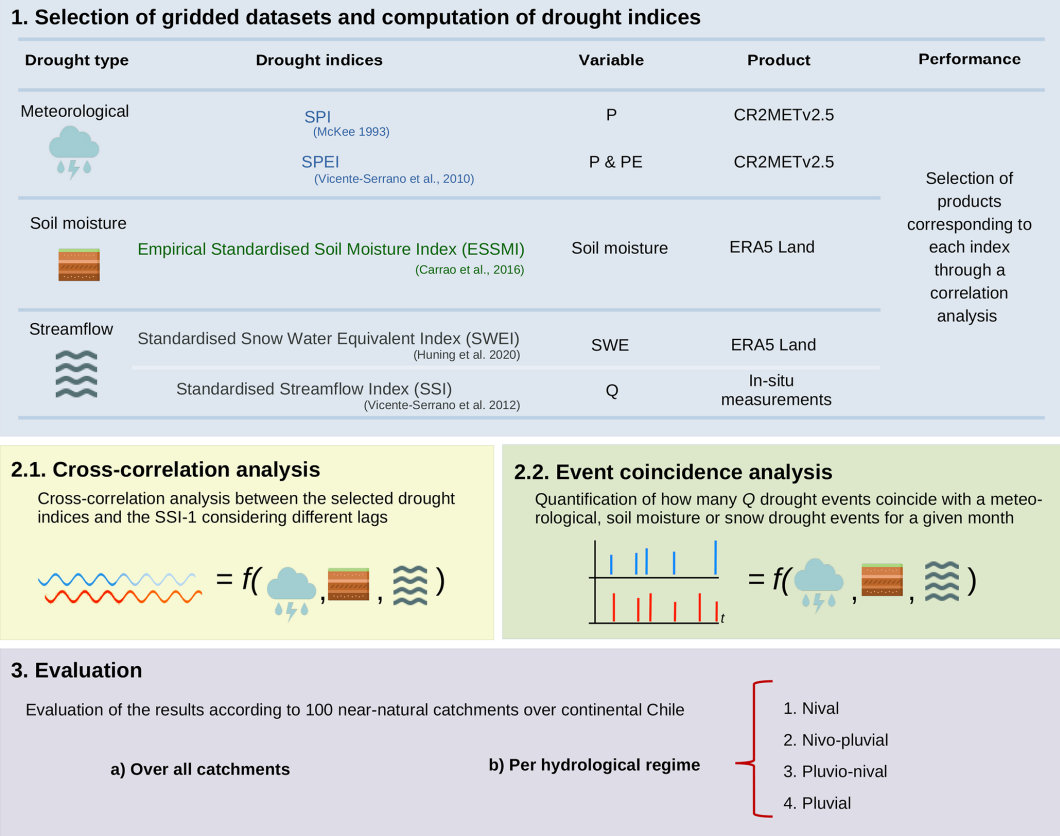Article on hydrological drought monitoring published in HESS
by Mauricio Zambrano-Bigiarini
On March 28th, 2024, Hydrology and Earth System Sciences published the article entitled On the timescale of drought indices for monitoring streamflow drought considering catchment hydrological regimes. This study investigates the suitability of different drought indices and temporal scales for monitoring streamflow drought in catchments with different hydrological regimes.
Considering the lack of consensus on which drought indices and temporal scales are most appropriate for monitoring hydrological droughts, and the growing interest in the use of spatially distributed drought indices in ungauged areas (i.e, without streamflow data), this study addresses the following questions:
i) Which temporal scales of precipitation-based indices are best suited to assess streamflow drought in catchments with different hydrological regimes?
ii) Are soil moisture indices superior to meteorological indices as proxies of streamflow drought?
iii) Are snow indices more effective than meteorological indices for assessing streamflow drought in snow-influenced catchments?
To answer these questions, we investigated 100 near-natural catchments in Chile with four hydrological regimes (nival, nivo-pluvial, pluvio-nival, and pluvial), using the standardised precipitation index (SPI), the standardised precipitation evapotranspiration index (SPEI), the empirical standardised soil moisture index (ESSMI), and the standardised snow water equivalent index (SWEI), aggregated over different temporal scales. Cross-correlation and event coincidence analyses were performed between these indices and the standardised streamflow index on a temporal scale of 1 month (SSI-1), as representative of streamflow drought events.
Our results reveal that no single drought index and temporal scale can be recommended for all catchments and hydrological regimes, and that snow-influenced catchments require drought indices with larger temporal scales. In particular, for snowmelt-driven catchments characterised by a slow response of runoff to precipitation we recommend SPI-12 and SPI-24 as the best proxy indices for characterising streamflow droughts. In contrast, for faster-response rainfall-driven catchments we recommend the SPI-3 as the best proxies. Although soil moisture and snowpack are key variables that modulate the propagation of meteorological deficits into hydrological ones, the SPI and SPEI meteorological indices generally outperformed the soil moisture and snowpack-based indices in monitoring streamflow drought. Finally, to exclude the influence of non-drought periods, we recommend using the event coincidence analysis, a method that helps to assess the suitability of meteorological, soil moisture, and/or snowpack-based drought indices as proxies for streamflow drought events.
The supplementary material to this article contains much aditional information on:
- the selection of soil moisture and SWE products (S1),
- the temporal scales with the highest cross-correlation and event coincidence rates (S2),
- boxplots for analysing the cross-correlation and event coincidence on different temporal scales and with different lag times (S3),
- spatial analysis for cross-correlation and event coincidence analysis at different temporal scales and lag times (S4),
- boxplots for the cross-correlation analysis for different hydrological regimes (S5),
- boxplots for the event coincidence analysis for different hydrological regimes (S6),
- difference between parametric and non-parametric approach for the calculation of drought indices for soil moisture (S7),
- summary of them median monthly P and Q values for all selected catchments (S8), and
- figures with the median monthly P and Q values for all selected catchments (S9).
This work is the result of years of international collaboration with Dr. Oscar M. Baez-Villanueva, collecting and analysing different gridded datasets of key meteorological variables, since the ANID Fondecyt 11150861 project in 2017. In particular, this article was an integral part of the project ANID-Sequía FSEQ210001 lead by Camila Álvarez-Garretón and Juan Pablo Boisier at the Center for Climate and Resilience Research CR2, and received additional funding from the research projects ANID Fondecyt Regular 1212071 and ANID-PCI NSFC190018 led by me at Universidad de La Frontera, Chile.
I hope that the results of this article can be considered by the General Directorate of Water of Chile (DGA) to improve the criteria used to monitor and identify hydrological droughts in Chile, within the framework of water scarcity declarations (Res. Exe. DGA No. 1331/2022, and articles 314 and 315 of the Chilean Water Code).
The full article can be found here: https://doi.org/10.5194/hess-28-1415-2024.

Subscribe via RSS
